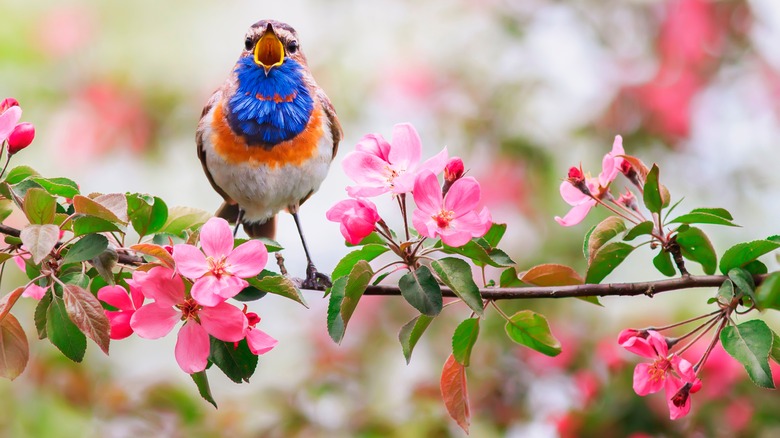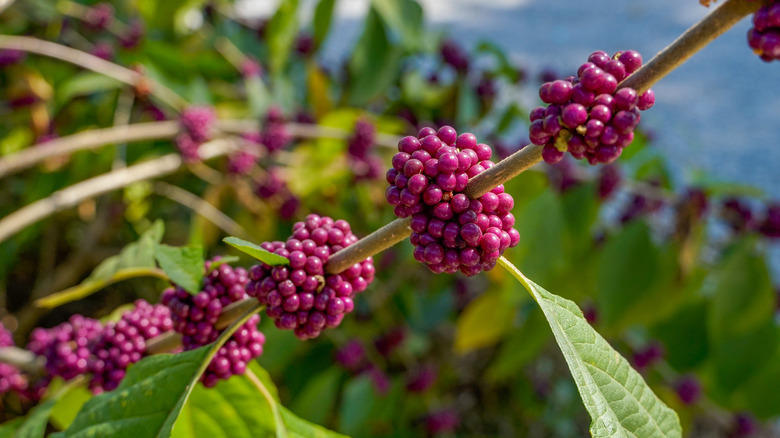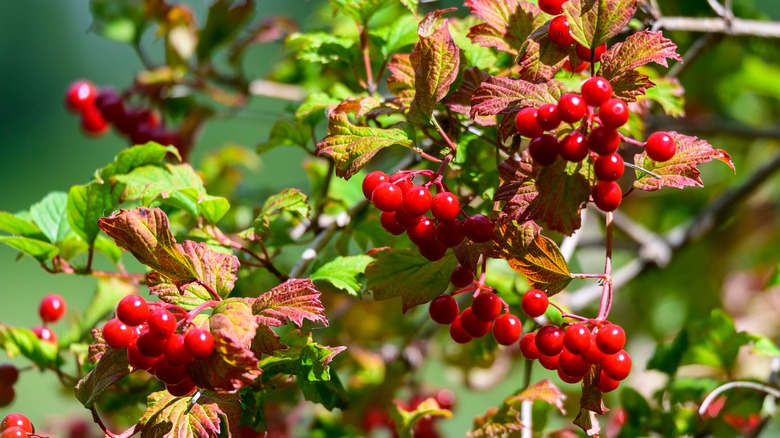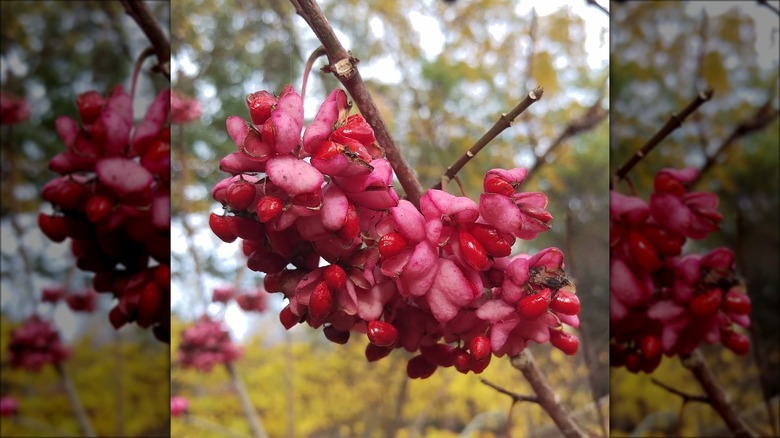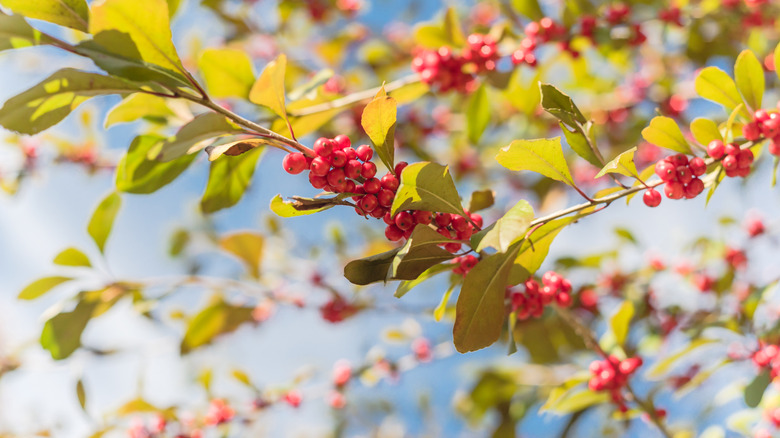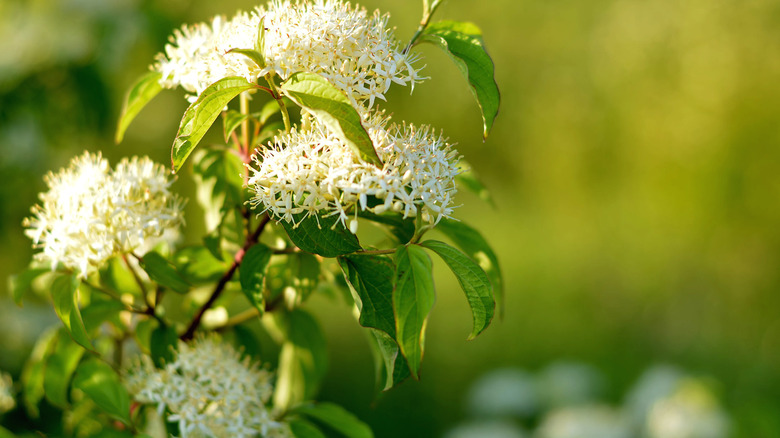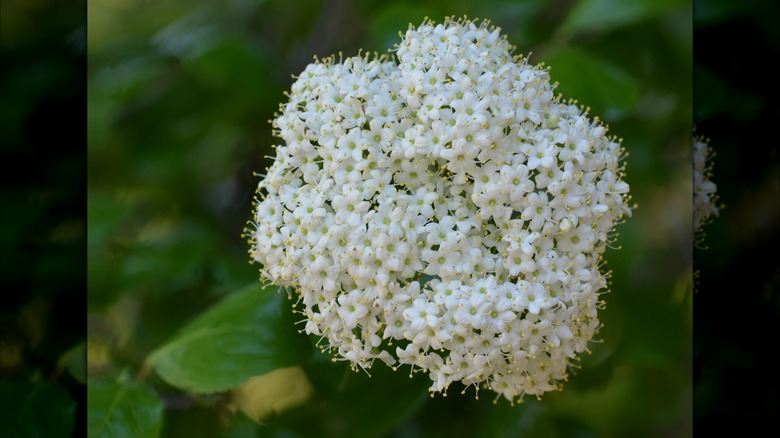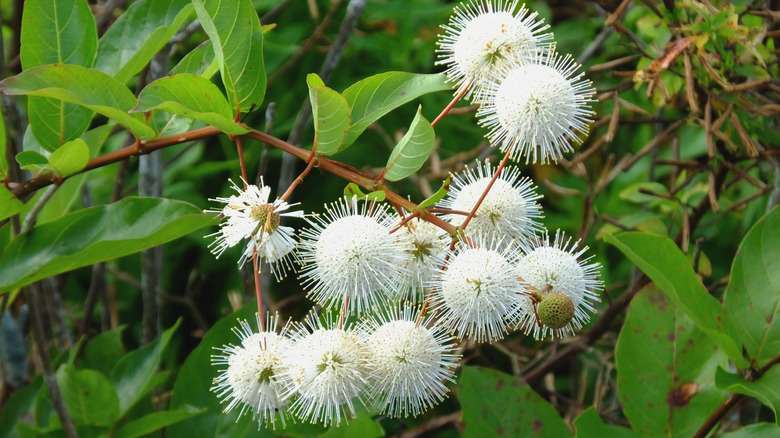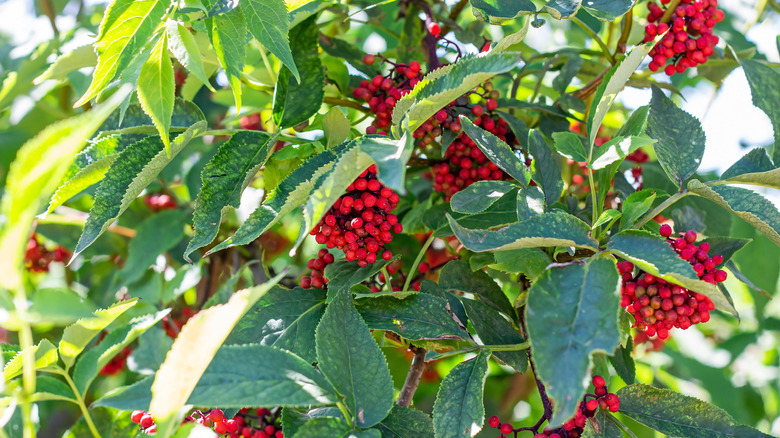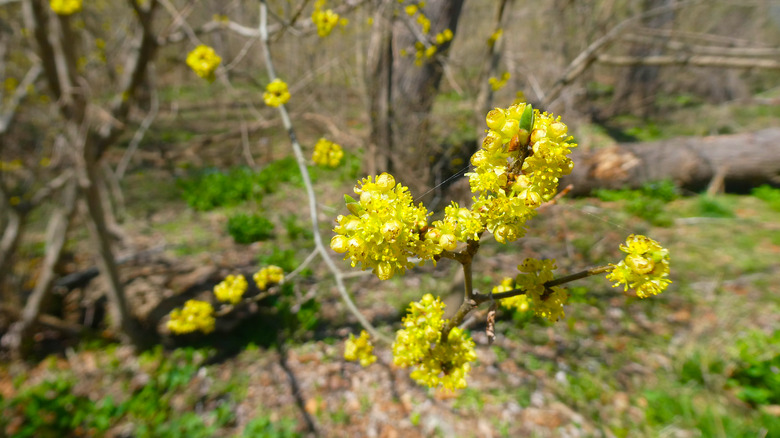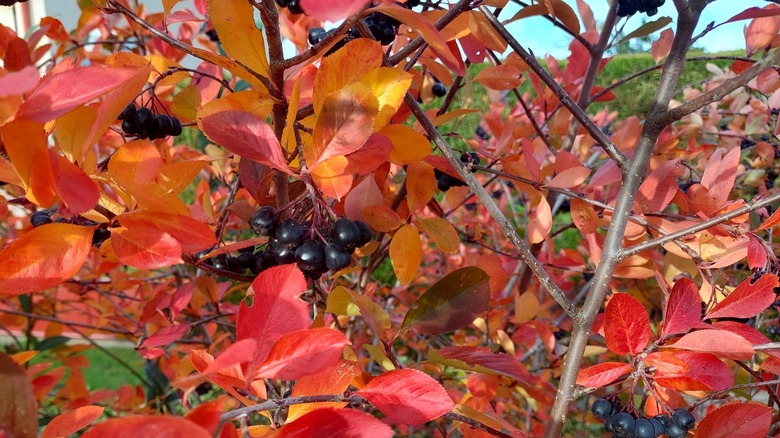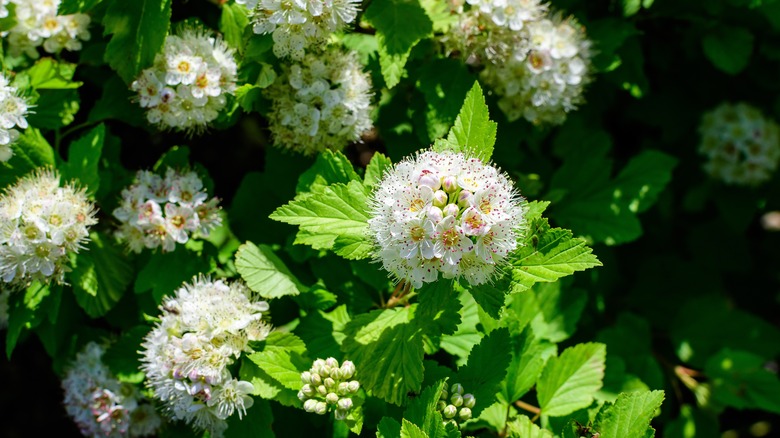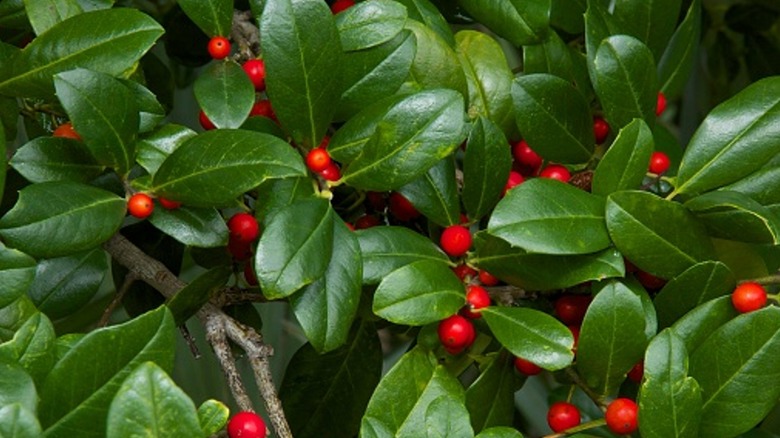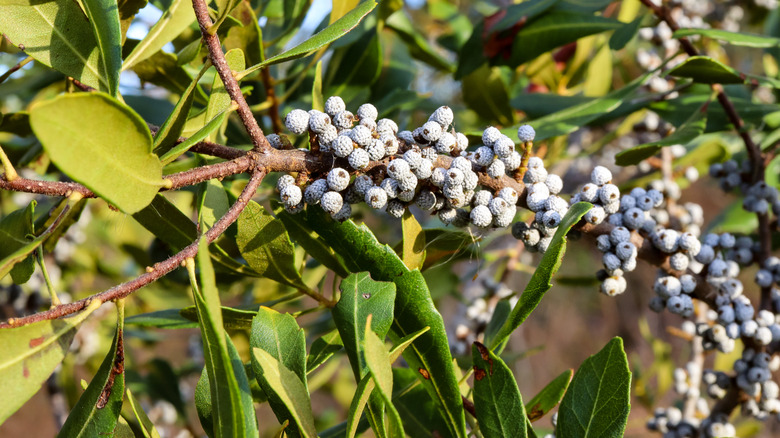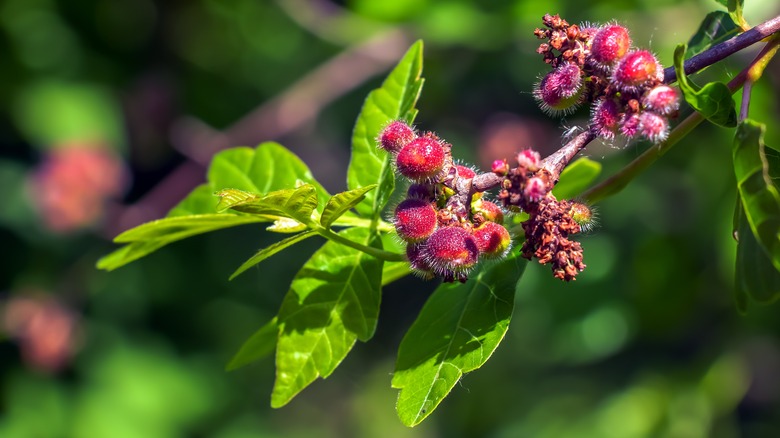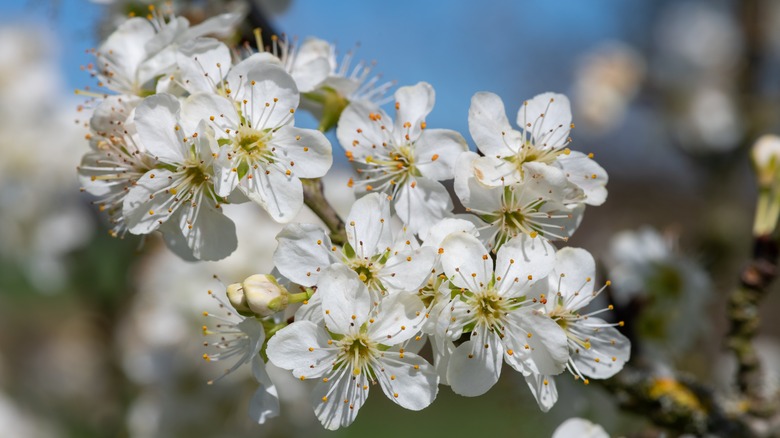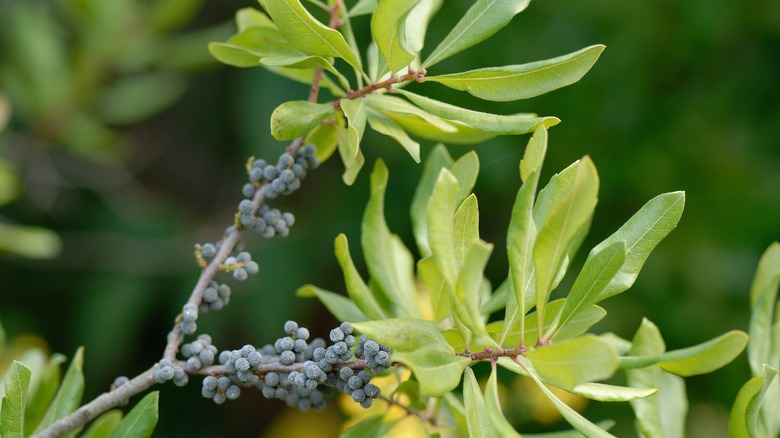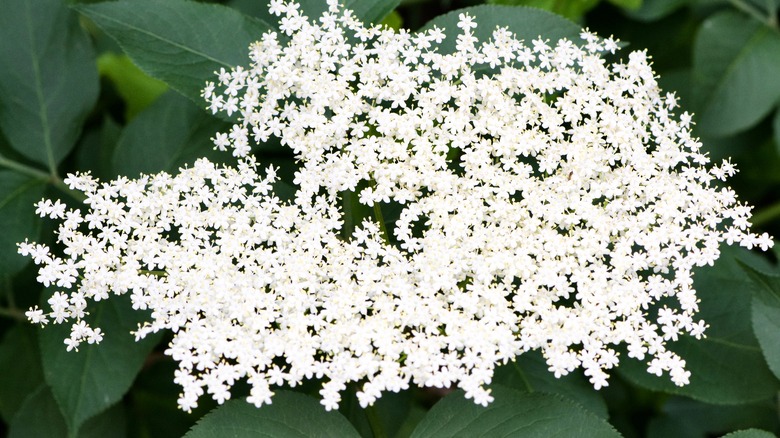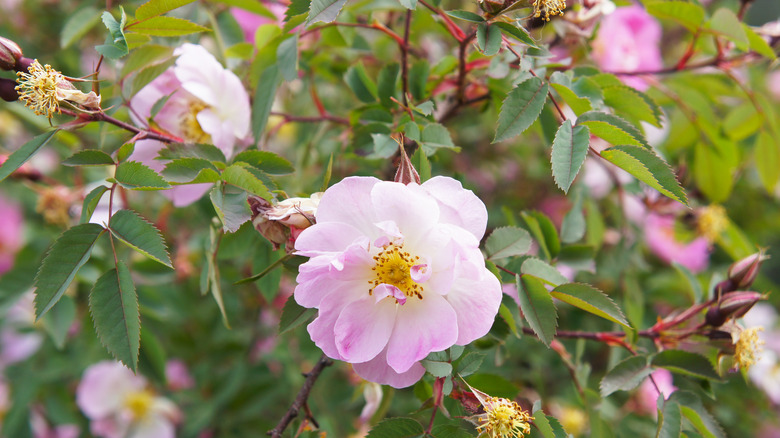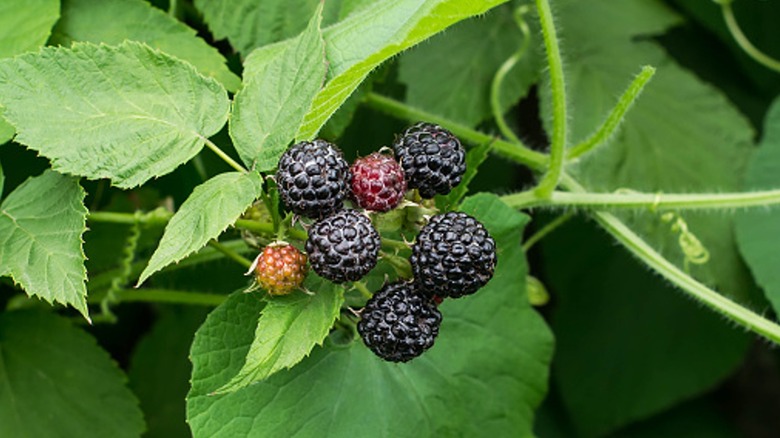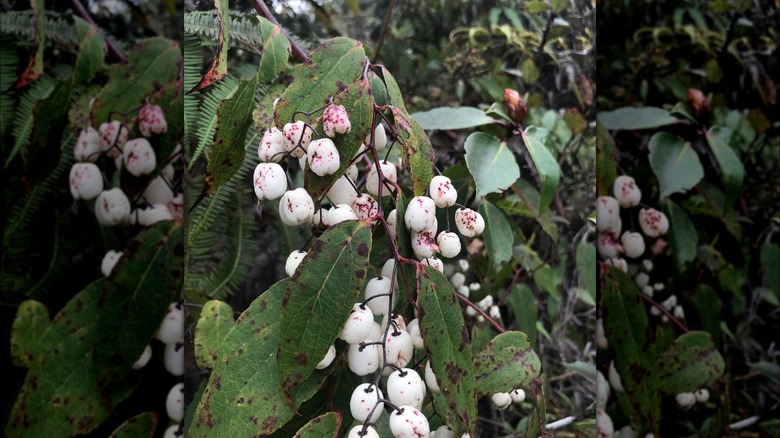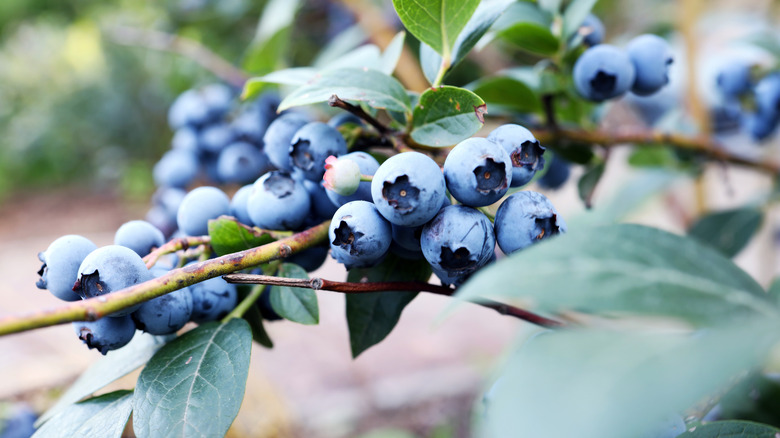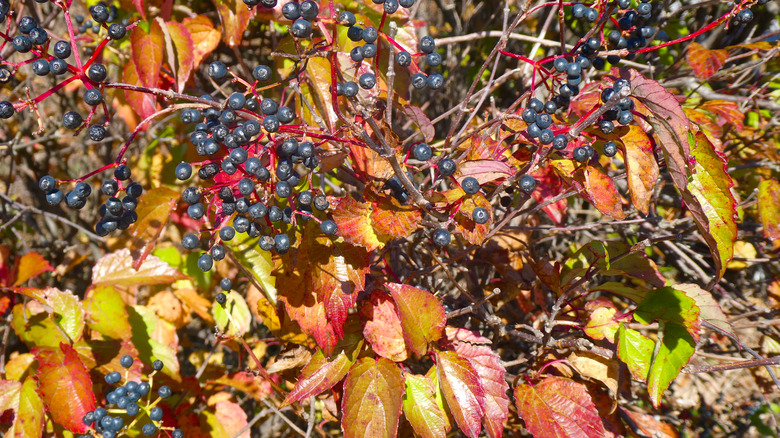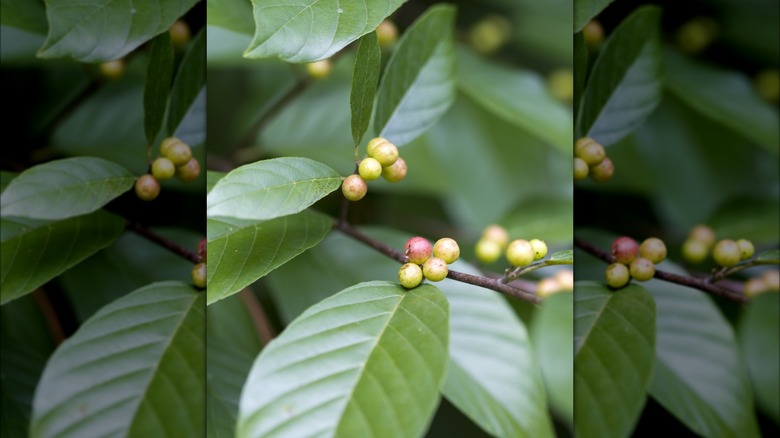Attract More Songbirds To Your Garden By Planting These 23 Beautiful Shrubs
What connects golden-winged warblers, pinyon jays, Bicknell's thrushes, and black rosy-finches? A song, perhaps, since they all belong to "Passeriformes," an order carved out specially for songbirds. Worryingly, though, they've all lost over half of their brethren in the last 50 years, and are set to lose a half more in the next 50, hence earning the label of "Tipping Point Species," per the 2022 State of the Birds report. Worse, they aren't alone in their suffering, with many resident and migratory birds flocking to a similar foreboding future. But your small garden patch can be of great assistance. If planned right, it could soon grow into a favorite haunt for dozens of songbirds stopping by while en route for their seasonal emigration.
To borrow a leaf from the birdscaping tips to turn your yard and garden into a bird haven playbook, planting certain shrubs to attract more songbirds works because it provides them with a mix of food, shelter, and escape cover (you're likely sorted on the water front with birdbaths). However, diversity is key. Ideally, your spring-summer mix should include insect-attracting shrubs like highbush blueberry or elderberry that invite nesting mothers in, while fruit-bearing plants like alternate-leaf dogwood and sumac should become the focus when the weather cools. Also, grow at least three of each plant species — mixed hedgerows work — for greater results. Read on to know your songbird-friendly shrubbery options.
1. American beautyberry
By bursting moisture-rich amethyst fruits that wrap around the copperish-gray stems like bracelets, American Beautyberry (Callicarpa americana) plants lay out a lavish spread for over 40 songbird varieties, including purple finches, American robins, and brown thrashers during fall through early winter. Endemic in the US' southeastern and central regions, the low-maintenance shrub is equally adapted to wet and dry soils. Grow the 8-foot-tall plant at the border's back in zones 6 to 10 to mask its bare spring presence and keep mosquitoes out of your yard.
2. Common winterberry
Starring glossy red berries on snow-roofed bare branches, common winterberry (Ilex verticillate) is a living rendition of a lovely Christmas card, and an outdoor plant that thrives in winter weather. Cedar waxwings and 47 other songbirds flock to their drupes during the lean food season, while butterflies keep the yard busy by flitting among spring-blooming greenish-white petals. The multi-stemmed, 12-foot-wide native is suited for zones 3 through 9. It serves as a living hedge, able to provide space for several bird nests in its glossy wine-black foliage. Remember, you must couple male and female cultivars within 50 feet of each other for berries.
3. Eastern wahoo
Painting the landscape a ravishing lavender with its spring through summer blooming flowers, eastern wahoo (Euonymus atropurpureus) is a good alternative for invasive burning bush plants while adding colossal wildlife value. Charming diverse flies and bees into the yard, the native shrub provides glorious burgundy-red fall color that beautifies the garden's hedge or privacy. Its red fruits are consumed by cardinals, northern flickers, and eastern bluebirds. Performing best in dappled shade, the over 12-foot-tall shrub can tolerate compacted soils.
4. Possumhaw
Winter hardy in zones 5 to 9, Possumhaw (Ilex decidua) is an interesting addition in clay or boggy sites for its clump-forming green foliage that turns a chartreuse yellow as the summer ends. Its best feature, though, is the orange-red fruit that persists through the winter, dotted with numerous songbirds and rodents who prize the ice-weathered taste. However, you must couple the fruit-bearing female plants with male counterparts for a good crop. For instance, the heavy fruit setting 'Warren's Red' cultivar can be paired with 'Red Escort.' Plant in full sun, as it gains tree-like height in partial shade.
5. Alternate-leaf dogwood
Growing over 15 feet tall, alternate-leaf dogwood (Cornus alternifolia) provides nesting territory to songbirds like wood thrushes, black-throated green warblers, and robins who prefer staying at middling heights. While waiting for the green drupes to ripen into their irresistible bluish-black tones in sweltering summer, the songbirds pick off the scores of larvae that the plant often hosts. Happiest in cold climates, despite being vulnerable to frost injury, the native shrub grows best in acidic, organically-rich, moist soils in growth zones 3 to 7. Featuring tiered foliage (like a pagoda), the deer-resistant plant turns a festive red come fall.
6. Blackhaw viburnum
Boasting blue or maroon berries from fall through winter, blackhaw (Viburnum prunifolium) is a treasured food source for cardinals, bluejays, and mockingbirds when food becomes scarce, although they're safe for human consumption as well. As the 20-foot-tall shrub packs its multiple stems into thickets, it doubles up as a nifty home for assorted birds and small mammals. The low-maintenance, drought-resistant native thrives in part to full sun in USDA zones 3 to 9. As a specimen or border accent, it enlivens the yard with its pollinator-friendly, aromatic white flowers and mauve fall color. Can survive in alkaline soils.
7. Buttonbush
Native to most US regions, buttonbush (Cephalanthus occidentalis) shrubs are one of the beautiful plants that thrive in clay soil since they tolerate both compaction and extended periods of standing water. While their perfumed mass of white flowers explodes in star-esque beauty, calling forth pollinators and hummingbirds in summer, their showy fruits keep an array of songbirds, including robins and towhee, satiated through the winter chill. Bundling its copper stems into thickets, the 8-foot-tall shrub houses blackbirds and flycatchers. Site in full to part sun in acidic substrates in zones 5 through 11.
8. Red elderberry
Stippled with show-stopping colors, red elderberry (Sambucus racemosa subsp. Pubens) heartens hummingbirds into returning to your yard along with different songbirds, including western tanagers and robins. They bear sour, burgundy fruits right when the mother birds are looking to fatten up their babies (mid-summer) and make up a greater part of the meal of migratory rose-breasted grosbeaks in the fall. Their over 4-foot tall, vase-shaped canopies also serve as alights or habitats, from which avians snack on insects. Pop in sunny areas in zones 3 to 7, but prune the native religiously come winter, lest it turn weedy.
9. Spicebush
A hothouse for swallowtails, spicebush (Lindera benzoin) plants are equally loved by wood thrushes who refuel on their fat-rich spicy drupes while migrating down south. In fact, the cat-sounding gray catbird, red-eyed vireo, northern flickers, and many more flock over to the 6-foot tall, deciduous shrub every chance they get, imbuing your garden with a chaotic chorus. The shade-tolerant native is a low-maintenance alternative for exotic forsythia plants, washing your garden in luminous yellows in early spring. Cold hardy in zones 5 to 9, you must grow at least one male pollinator to fertilize the female plants.
10. Black chokeberry
Belying all expectations, black chokeberry's (Aronia melanocarpa) sour, lilac-black berries have quite the following among songsters, including cedar waxwings, chickadees, and orioles. Endemic in the eastern US region, the nearly 10-foot shrub enhances the garden with pinkish-white flowers come spring, donning an overcoat of purplish-red foliage in the fall. Winter hardy in growth zones 3 to 8, chokeberry adapts to all soil conditions, including bogs, clay texture, or dryness, so long it's planted in full (or at least partial) sun. Planting in groups improves pollination, but you must keep track of root suckers before they become intrusive.
11. Atlantic ninebark
Although gardeners gravitate to ninebark (Physocarpus opulifolius) for its exfoliating bark that looks out-and-out magnificent against a snowy backdrop, there's a smorgasbord of other benefits the native shrub has on the menu. It's impervious to drought and heat, yet hardy up to zone 2, and endures occasional flooding and compaction. Its summer-springing maroon fruits are often strewn with myriad songbirds and small mammals until they crack mid-winter. While all varieties are festooned with orange or pink-eyed, white flowers, their purple-leaved cultivars, such as 'Burgundy Candy,' 'Summer Wine,' and 'Coppertina,' are especially alluring in moderately shaded gardens.
12. Yaupon holly
Imagine mockingbirds darting around your yard in their ravenous haze during snowy winters — that imagery can come alive by growing yaupon holly (Ilex vomitoria), albeit at the price of having the evergreen shrub stripped off all its glossy red berries. Indigenous to the US, yaupon holly makes a beautiful espalier, windbreak, or privacy hedge when grouped, given its densely-packed, 10 by 8 feet frame (also used as winter cover by wildlife). Planting a non-flowering male counterpart is essential for berries. It tolerates deep shade, drought, and salt and grows well in zones 7 through 9.
13. Wax myrtle
With a history of its gray fruits' coverings being boiled to create spicy bayberry candles, wax myrtle (Myrica cerifera, formerly Morella cerifera) has since then improved its standing by becoming a butterfly and songbird magnet. Happiest in zones 7 to 11, the evergreen shrub may shed some leaves in higher latitudes from cold stress. While the fast-growing native is a tad moisture-hungry during establishment, it quickly adapts to drought, swamp, salt, or gales. However, given its high inflammability risk, it's best planted away from your home, either along pavements or in herb gardens. Don't forget to watch out for suckers.
14. Fragrant sumac
Capable of rooting in the driest soils of zones 3 to 9, Fragrant sumac (Rhus aromatica) is an unmissable addition for those desirous of pandering to songbirds. Sumac's hairy ruby drupes look especially becoming in the beaks of ruffed grouse, flickers, sparrows, and goldfinches, late summer through winter. Their over 6-foot-wide sprawl is brilliant as a groundcover (and shelter), courtesy of the switch to vivid orange or mauve fall colors and lemony scent. While they tolerate fractional shade, clay, black walnut, and deer, they can spread aggressively if left unchecked.
15. Chickasaw plum
An early spring bloomer, the Chickasaw plum (Prunus angustifolia) is renowned for providing birds, including brown thrashers, northern mockingbirds, and northern bobwhites, with crucial nesting and roosting space, and summery yellow fruits. However, the bird composition varies as the shrubs mature. Happiest in moist beds or under shade trees in zones 5 to 8, the wild plums can send out root suckers. But you can dig them out to keep the shrub localized while enabling your gardening friends' quest for a bird haven. 'Guthrie' cultivar works better in small gardens, as plums can grow 15 feet tall. Not pet-friendly.
16. Northern bayberry
If raccoons are staking your yard, planting northern bayberry (Myrica pensylvanica) may encourage some passerines like yellow-rumped warblers, cedar waxwings, chickadees, and mockingbirds to brave through since they can hide in the 10-foot-wide thicket. That way, they can also snack on the sweet-smelling gray fruits from fall to early spring. Bayberry's high drought and salt resistance makes it a worthy addition in desert areas where it further creates nitrogen-rich microclimates for its understory companions. However, it may spike allergies and sprawl beyond its boundaries. In compact spaces, grow female cultivars like 'Morton' and supplement with a male pollinator.
17. American black elderberry
A wildlife magnet, planting American black elderberry (Sambucus canadensis) is a sure-shot way to create a thriving ecosystem in your garden, with tons of moths, butterflies, rodents, mammals, and birds favoring it for winter cover and food. From red-shafted flickers, Stellar jays, black-headed grosbeaks, hooded orioles to mockingbirds, masses of songbirds rely on the 12-foot-tall shrub's dark blue drupes for a summer diet. And if they spare a few, you can process the berries into jams and jellies. Clip the suckers to keep the shrubs confined. Hardy up to zone 4 in full-to-part sun.
18. Swamp rose
You might not enjoy roses for their thorns and diva disposition, but perhaps songbirds' fervor, the beautiful, gorgeous-smelling flowers, and the intense crimson-red fall interest may change your mind. While the vitamin C-rich pea-sized, ripe seeds aren't exactly savory, they make good winter food when they've turned mushy. Rampant in east US, the 6-foot briar patch is often peppered with bird nests unless you've had the roses climb up walls or trellises, hence serving as escape points. Despite the name, swamp roses tolerate flooding ever so occasionally, preferring acidic, moist sites in USDA zones 4 through 9.
19. Black raspberry
Sprouting sweet burgundy-black fruits, black raspberry (Rubus occidentalis) has won songsters' hearts. Titmice, blue jays, orioles, cardinals, and many more gorge on the fruit, and then some more in chilly winters when only the crescent-shaped seeds remain. They also like nesting in black raspberry's 6-foot-tall prickly branches, probably because of the ready supply of copious caterpillars, ants, grasshoppers, and other tiny critters. Hardy in zones 4 through 8, the deciduous shrub flourishes in partial shade, although it can take full sun if watered adequately. Susceptible to honey fungus and a potential vermin magnet.
20. Gray dogwood
Although not as flashy as their silky dogwood cousins, gray dogwoods (Cornus racemose) have a better chance of charming gray catbirds and mockingbirds, as their beautiful black mottled, white fruits contain higher fat content. They similarly captivate their onlookers with red, honeysuckle-ish stalks and enigmatic fall colors, where their green foliage sparkles in shades of pink, yellow, and mauve. Although indigenous in central and east US, the over 10-foot-tall shrub can dominate other species if its suckers aren't pruned in time. Hardy up to zone 4, the pollinator-friendly shrub is best saved for disturbed or deeply shaded sites.
21. Highbush blueberry
If your garden has exceedingly acidic (pH approximating 5.0), soaking wet, or highly compacted soils, highbush blueberries (Vaccinium corymbosum) are worth your consideration. Not only do they progressively daub your landscape in crimson-greens, summery blues, and eventually purplish-orange colors through their chameleon foliage, but also liven it up with the ballads from rufous-sided towhee, scarlet tanager, gray catbird, and eastern bluebird, to name a few songbirds. When sited in sunny zones 3 to 8, they grow over 6 feet tall and wide. Grow multiple varieties with synchronous blooms for best yields.
22. Southern arrowwood
Growing level, narrow silver stems, that were historically used as shafts for arrows — hence the name — southern arrowwood (Viburnum dentatum) is another beautiful shrub to attract more songbirds. Catbirds, robins, thrushes, and bluebirds are drawn to the fire-resistant shrub for its dark blue berries that persist through summer and fall. In contrast, vireos, buntings, and warblers treat the deciduous patch as nesting territory. Thriving in USDA zones 3 to 8, the deer-impervious ornamental can grow to 10 feet in width and height when grown in modest shade. They're best grown from cuttings, as seeds take two years to germinate.
23. Carolina buckthorn
To invite a legion of singing chums, including gray catbirds, grosbeaks, and waxwings to your garden, plant Carolina buckthorn (Frangula caroliniana). They appreciate the burgundy-black fruits that adorn the fuzzy brown branches in the fall. Native to central and southern parts of the US, buckthorn shrubs are best grown in full sun as hedges or perennial borders. However, they can live in moderate shade. They prefer alkaline soils, scaling more than 10 feet by maturity in zones 5 to 9.
